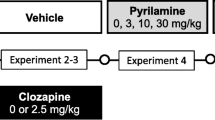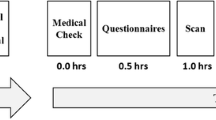Abstract
Previously it has been shown that 5-hydroxytryptamine (5-HT)1A agonists such as 8-hydroxy-2-(di-n-propylamino)tetralin (8-OH-DPAT) and gepirone increase food intake in free-feeding rats. These experiments were conducted to examine the possible influence of taste and textural factors on the feeding responses induced by these two drugs. Separate groups of non-water-deprived rats were given access to one of a variety of different solutions of saccharin (0.02, 0.04, 0.20 and 2.0% w/v) or water for 2 h each day. Rats were then treated with different doses of 8-OH-DPAT (10, 60 or 100 µg/kg) or gepirone (1 or 2.5 mg/kg) in a repeated measures design. Under saline injection an inverted-U shaped concentration-response curve was obtained, with the highest level of intake occurring in rats drinking from the 0.20% saccharin solution. The highest doses of 8-OH-DPAT and gepirone suppressed drinking of saccharin, particularly over the first 30 min of the test period, leading to a flattening of the concentration response curve. At 2 h post-injection 60 µg/kg 8-OH-DPAT enhanced the consumption of the 0.04% saccharin solution only. In a second experiment, 8-OH-DPAT or gepirone was administered to rats eating either standard pelleted chow or the same food presented in powdered form. Both drugs stimulated feeding. However, interactions with food type were found. At 60 and 100 µg/kg 8-OH-DPAT increased eating of both food types equally, but with 500 µg/kg rats are significantly more of the pelleted food. Gepirone at 1 and 2.5 mg/kg also significantly increased pelleted food intake compared to powdered food intake. These results suggest that taste factors alone are unlikely to be a major determinant of 8-OH-DPAT's effects on food intake. On the other hand, food texture may play a significant role in the capacity to elicit feeding after high doses of both 8-OH-DPAT and gepirone.
Similar content being viewed by others
References
Bendotti C, Samanin R (1986) 8-hydroxy-2-(di-n-propylamino)tetralin (8-OH-DPAT) elicits eating in free feeding rats by acting on central serotonin neurons. Eur J Pharmacol 121:147–150
Beninger RJ (1983) The role of dopamine in locomotor activity and learning. Brain Res Rev 6:173–196
Chaouloff R, Serrurier B, Merino D, Laude D, Elghozi J-L (1988) Feeding responses of a high dose of 8-OH-DPAT in young and adult rats: influence of food texture. Eur J Pharmacol 151:267–273
Davies M, Sloley BD, Fletcher PJ (1989) Neurochemical, electrophysiological and behavioural evidence that 8-OH-DPAT stimulates central dopamine systems. Soc Neurosci Abst 15:553
Dourish CT, Hutson PH, Curzon G (1985) Low doses of the putative serotonin agonist 8-hydroxy-2-(di-n-propylamino)tetralin (8-OH-DPAT) elicit feeding in the rat. Psychopharmacology 86:197–204
Dourish CT, Cooper SJ, Gilbert F, Coughlan J, Iversen SD (1988a) The 5-HT1A agonist 8-OH-DPAT increases consumption of palatable wet mash and liquid diets in the rat. Psychopharmacology 94:58–63
Dourish CT, Clark ML, Iversen SD (1988b) 8-OH-DPAT elicits feeding and not chewing: evidence from liquid diet studies and a diet choice test. Psychopharmacology 95:185–188
Dray A, Davies J, Oakley NR, Tongroach P, Vellucci S (1978) The dorsal and medial raphe projections to the substantia nigra in the rat. Electrophysiological biochemical and behavioural observations. Brain Res 151:431–442
Fletcher PJ (1987) 8-OH-DPAT elicits gnawing and eating of solid but not liquid foods. Psychopharmacology 92:192–196
Fletcher PJ, Davies M (1990a) The involvement of 5-hydroxytryptaminergic and dopaminergic mechanisms in the feeding induced by buspirone, gepirone and ipsapirone. Br J Pharmacol 99:519–525
Fletcher PJ, Davies M (1990b) A pharmacological analysis of the eating response induced by 8-OH-DPAT injected into the dorsal raphe nucleus reveals the involvement of a dopaminergic mechanism. Psychopharmacology 100:188–194
Gilbert F, Dourish CT (1987) Effects of the novel anxiolytics gepirone, buspirone and ipsapirone on free feeding and on feeding induced by 8-OH-DPAT. Psychopharmacology 93:349–352
Gower AJ, Tricklebank MD (1988) α2-Adrenoceptor antagonist activity may account for the effects of buspirone in an anticonflict test in the rat. Eur J Pharmacol 155:129–137
Hutson PH, Dourish CT, Curzon G (1986) Neurochemical and behavioural evidence for mediation of the hyperphagic action of 8-OH-DPAT by 5-HT cell body autoreceptors. Eur J Pharmacol 129:347–352
Leander J (1989) Effects of selective serotonergic agonists on palatability-induced ingestion. In: Bevan PLT, Cools AR, and Archer T (eds) Behavioural pharmacology of 5-HT. Lawrence Erlbaum Associates, New York, pp 287–290
Lynch C, Libby L (1983) Naloxone suppresses intake of highly preferred saccharin solutions in food deprived and sated rats. Life Sci 33:1909–1914
McMillen BA, Scott SM, Williams HL, Sanghera MD (1987) Effects of gepirone, an aryl-piperazine anxiolytic drug, on aggressive behavior and brain monoaminergic neurotransmission. Naunyn-Schmiedeberg's Arch Pharmacol 335:454–464
Mittman SM, Geyer MD (1989) Effects of 5-HT1A agonists on locomotor and investigatory behaviors in rats differ from those of hallucinogens. Psychopharmacology 98:321–329
Middlemiss DN, Fozard JF (1983) 8-Hydroxy-2-(di-n-propylamino)tetralin discriminates between sub-types of the 5-HT1 recognition site. Eur J Pharmacol 90:151–153
Montgomery AMJ, Willner P, Muscat R (1988) Behavioural specificity of 8-OH-DPAT-induced feeding. Psychopharmacology 94:110–114
Montgomery AMJ, Rose IC, Herberg LJ (1991) Effect of the 5-HT1A agonists, 8-OH-DPAT and buspirone, on brain stimulation reward: evidence for dopaminergic activity. J Neural Transm (in press)
Muscat R, Montgomery AMJ, Willner P (1989) Blockade of 8-OH-DPAT-induced feeding by dopamine antagonists. Psychopharmacology 99:402–408
Papp M, Willner P (1989) Blockade by pimozide of place preference but not place aversion induced by the 5-HT1A agonist 8-OH-DPAT. Behav Pharmacol Suppl 1:13
Sanghera MK, Coke JA, Williams HL, McMillen BA (1990) Ipsapirone and 1-(2-pyrimidinyl)-piperazine increases rat locus coeruleus noradrenergic activity. Brain Res Bull 24:17–22
Tricklebank MD, Forler C, Fozard JR (1984) The involvement of subtypes of the 5-HT receptor and of catecholaminergic systems in the behavioural response to 8-hydroxy-2-(di-n-propylamino)tetralin in the rat. Eur J Pharmacol 106:271–282
White NW (1986) Control of sensorimotor function by dopaminergic nigrostriatal neurons: influence on eating and drinking. Neurosci Biobehav Rev 10:15–36
Wise RA (1978) Catecholamine theories of reward: a critical review. Brain Res 152:215–247
Wise RA (1987) The role of reward pathways in the development of drug dependence. Pharmacol Ther 35:227–263
Author information
Authors and Affiliations
Rights and permissions
About this article
Cite this article
Fletcher, P.J., Zack, M.H. & Coscina, D.V. Influence of taste and food texture on the feeding responses induced by 8-OH-DPAT and gepirone. Psychopharmacology 104, 302–306 (1991). https://doi.org/10.1007/BF02246027
Received:
Revised:
Issue Date:
DOI: https://doi.org/10.1007/BF02246027




